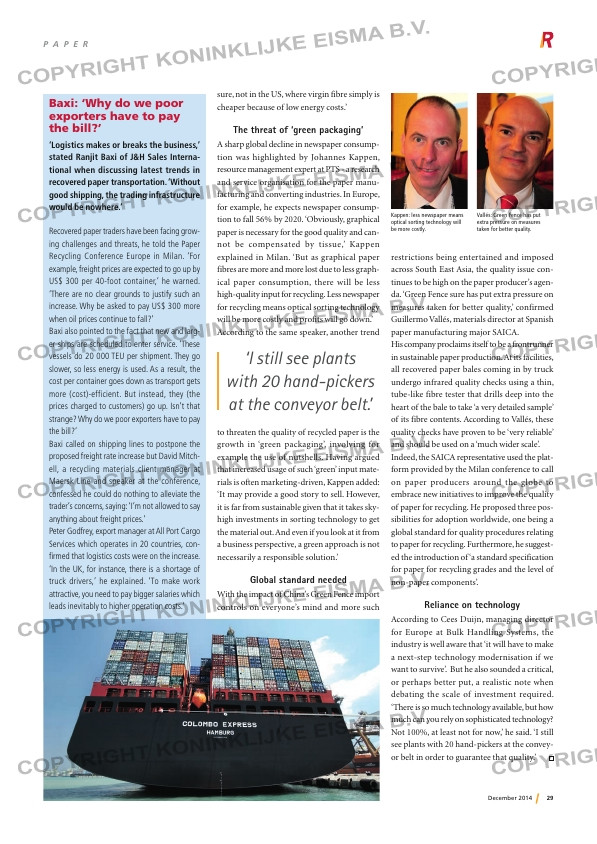Page 29 from: December 2014

29December 2014
P A P E R
sure, not in the US, where virgin fibre simply is
cheaper because of low energy costs.’
The threat of ‘green packaging’
A sharp global decline in newspaper consump-
tion was highlighted by Johannes Kappen,
resource management expert at PTS – a research
and service organisation for the paper manu-
facturing and converting industries. In Europe,
for example, he expects newspaper consump-
tion to fall 56% by 2020. ‘Obviously, graphical
paper is necessary for the good quality and can-
not be compensated by tissue,’ Kappen
explained in Milan. ‘But as graphical paper
fibres are more and more lost due to less graph-
ical paper consumption, there will be less
high-quality input for recycling. Less newspaper
for recycling means optical sorting technology
will be more costly and profits will go down.’
According to the same speaker, another trend
to threaten the quality of recycled paper is the
growth in ‘green packaging’, involving for
example the use of nutshells. Having argued
that increased usage of such ‘green’ input mate-
rials is often marketing-driven, Kappen added:
‘It may provide a good story to sell. However,
it is far from sustainable given that it takes sky-
high investments in sorting technology to get
the material out. And even if you look at it from
a business perspective, a green approach is not
necessarily a responsible solution.’
Global standard needed
With the impact of China’s Green Fence import
controls on everyone’s mind and more such
restrictions being entertained and imposed
across South East Asia, the quality issue con-
tinues to be high on the paper producer’s agen-
da. ‘Green Fence sure has put extra pressure on
measures taken for better quality,’ confirmed
Guillermo Vallés, materials director at Spanish
paper manufacturing major SAICA.
His company proclaims itself to be a frontrunner
in sustainable paper production. At its facilities,
all recovered paper bales coming in by truck
undergo infrared quality checks using a thin,
tube-like fibre tester that drills deep into the
heart of the bale to take ‘a very detailed sample’
of its fibre contents. According to Vallés, these
quality checks have proven to be ‘very reliable’
and should be used on a ‘much wider scale’.
Indeed, the SAICA representative used the plat-
form provided by the Milan conference to call
on paper producers around the globe to
embrace new initiatives to improve the quality
of paper for recycling. He proposed three pos-
sibilities for adoption worldwide, one being a
global standard for quality procedures relating
to paper for recycling. Furthermore, he suggest-
ed the introduction of ‘a standard specification
for paper for recycling grades and the level of
non-paper components’.
Reliance on technology
According to Cees Duijn, managing director
for Europe at Bulk Handling Systems, the
industry is well aware that ‘it will have to make
a next-step technology modernisation if we
want to survive’. But he also sounded a critical,
or perhaps better put, a realistic note when
debating the scale of investment required.
‘There is so much technology available, but how
much can you rely on sophisticated technology?
Not 100%, at least not for now,’ he said. ‘I still
see plants with 20 hand-pickers at the convey-
or belt in order to guarantee that quality.’
‘I still see plants
with 20 hand-pickers
at the conveyor belt.’
Baxi: ‘Why do we poor
exporters have to pay
the bill?’
‘Logistics makes or breaks the business,’
stated Ranjit Baxi of J&H Sales Interna-
tional when discussing latest trends in
recovered paper transportation. ‘Without
good shipping, the trading infrastructure
would be nowhere.’
Recovered paper traders have been facing grow-
ing challenges and threats, he told the Paper
Recycling Conference Europe in Milan. ‘For
example, freight prices are expected to go up by
US$ 300 per 40-foot container,’ he warned.
‘There are no clear grounds to justify such an
increase. Why be asked to pay US$ 300 more
when oil prices continue to fall?’
Baxi also pointed to the fact that new and larg-
er ships are scheduled to enter service. ‘These
vessels do 20 000 TEU per shipment. They go
slower, so less energy is used. As a result, the
cost per container goes down as transport gets
more (cost)-efficient. But instead, they (the
prices charged to customers) go up. Isn’t that
strange? Why do we poor exporters have to pay
the bill?’
Baxi called on shipping lines to postpone the
proposed freight rate increase but David Mitch-
ell, a recycling materials client manager at
Maersk Line and speaker at the conference,
confessed he could do nothing to alleviate the
trader’s concerns, saying: ‘I’m not allowed to say
anything about freight prices.’
Peter Godfrey, export manager at All Port Cargo
Services which operates in 20 countries, con-
firmed that logistics costs were on the increase.
‘In the UK, for instance, there is a shortage of
truck drivers,’ he explained. ‘To make work
attractive, you need to pay bigger salaries which
leads inevitably to higher operation costs.’
Vallés: Green Fence has put
extra pressure on measures
taken for better quality.
Kappen: less newspaper means
optical sorting technology will
be more costly.
RI-10 Paper.indd 29 04-12-14 14:32



